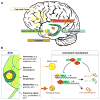When brain clocks lose track of time: cause or consequence of neuropsychiatric disorders
- PMID: 21737252
- PMCID: PMC3252427
- DOI: 10.1016/j.conb.2011.06.008
When brain clocks lose track of time: cause or consequence of neuropsychiatric disorders
Abstract
Patients suffering from neuropsychiatric disorders often exhibit a loss of regulation of their biological rhythms which leads to altered sleep/wake cycle, body temperature rhythm and hormonal rhythms. Whereas these symptoms have long been considered to result from the pathology of the underlying disease, increasing evidence now indicates that the circadian system may be more directly involved in the etiology of psychiatric disorders. This emerging view originated with the discovery that the genes involved in the generation of biological rhythms are expressed in many brain structures where clocks function-and perhaps malfunction. It is also due to the interesting phenotypes of clock mutant mice. Here we summarize recent reports showing that alteration of circadian clocks within key brain regions associated with neuropsychiatric disorders may be an underlying cause of the development of mental illness. We discuss how these alterations take place at both systems and molecular levels.
Copyright © 2011 Elsevier Ltd. All rights reserved.
Figures

References
-
- Ko CH, Takahashi JS. Molecular components of the mammalian circadian clock. Hum Mol Genet. 2006;15 (Suppl 2):R271–277. - PubMed
-
- Dardente H, Cermakian N. Molecular circadian rhythms in central and peripheral clocks in mammals. Chronobiol Int. 2007;24:195–213. - PubMed
-
- Mendoza J, Challet E. Brain clocks: from the suprachiasmatic nuclei to a cerebral network. Neuroscientist. 2009;15:477–488. - PubMed
Publication types
MeSH terms
Grants and funding
LinkOut - more resources
Full Text Sources
Medical

